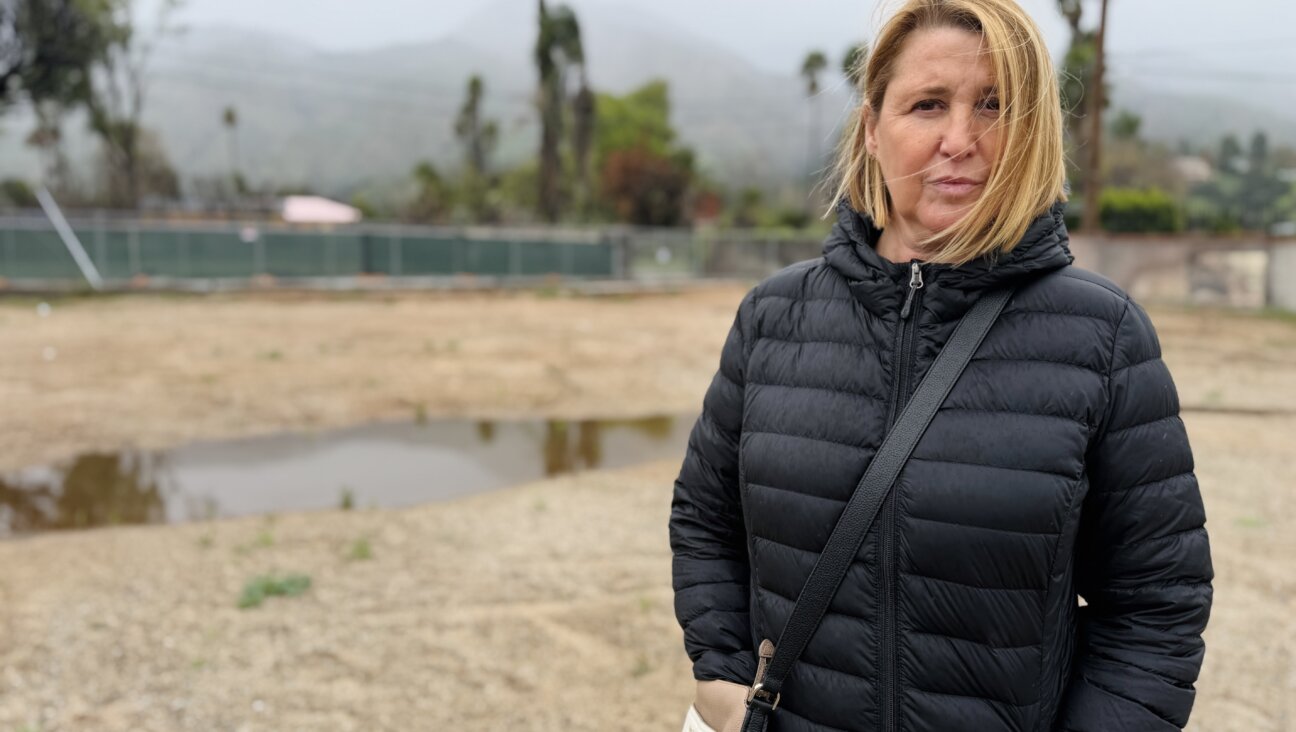‘They allowed Hezbollah to bombard it’: With Israel’s north on the brink of war, a chef commits to the land he loves
’When the sirens go off, I get a glass of wine,’ said Erez Komarovsky
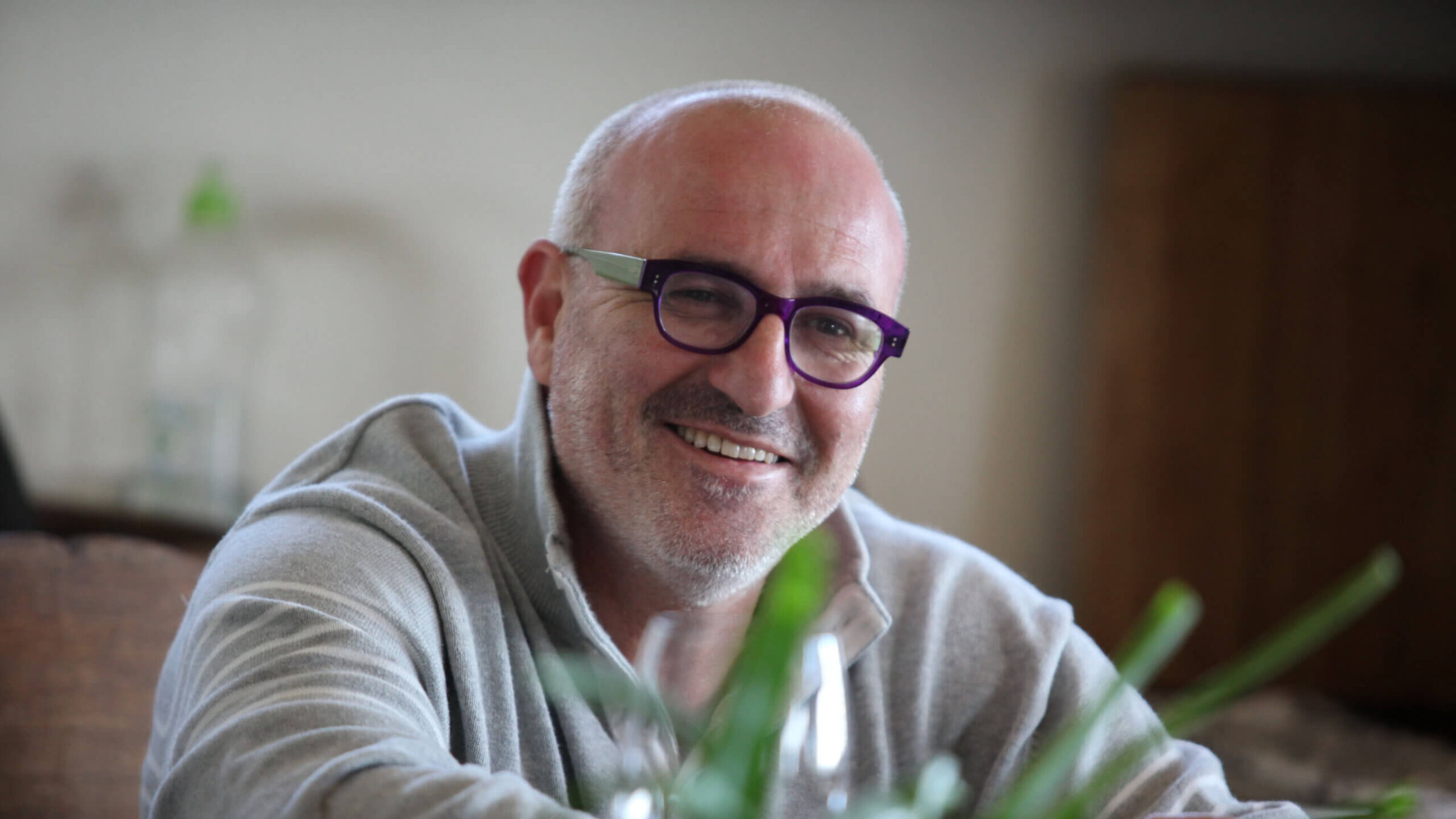
Erez Komarovsky at his home in Mattat. Photo by Oren Shalev / Alamy Photo
TEL AVIV—The biggest mistake the Israeli government made after Oct. 7, chef Erez Komarovsky told me, was telling residents of the country’s north to evacuate.
“The north became a no-man’s-land,” Komarovsky, who evacuated to Tel Aviv but still regularly visits his home in the north, said over lunch, “and they allowed Hezbollah to bombard it.”
The north is where Komarovsky’s heart is: The beautiful, bountiful region has shaped him as a chef, and as a person. Even in the shadow of what could be an even more devastating war than that currently raging in Gaza, Komarovsky, like many Israelis, believes that the evacuation was tantamount to surrender — that it made peace harder to obtain, not easier, and the prospect of eventually rebuilding unnecessarily daunting.
“Our village is empty,” said Komarovsky. “It has destroyed the community we built.”
Israel’s northern “second front” grew even more threatening this week. On Tuesday, a drone attack by Israel killed a senior Hezbollah commander in Beirut in retaliation for the terror group’s killing of 12 children in a missile attack on the Druze village of Majdal Shams, in the Golan Heights. On Wednesday, a bomb, widely believed to be planted by Israel, killed Hamas political leader Ismail Haniyeh during a visit to Tehran, and Iran vowed imminent revenge.
But to some stalwart northerners like Komarovsky, the dislocation they have undergone only made a bad situation worse, increasing a sense of surrender. It’s a sense of displacement that extends beyond his village, to the state of Israel itself.
“We really lost the idea that we are invincible,” he said.
Living between Tel Aviv and Mattat
Komarovsky, for his part, refuses to surrender.
Once each week, he gets in his car and drives 106 miles north, from the Tel Aviv apartment building his late grandfather, Meir Weissberg, who manufactured mattress springs, owned, to his home in the small community of Mattat in the northern Galilee, which has been under an evacuation order for eight months. The soldiers guarding checkpoints wave him through.
Komarovsky, 61, became famous in Israel for crafting food that uses the local produce and ingredients fused with the culinary traditions of Israel’s diaspora communities, as well as Palestinian and Middle Eastern cooking. His chain of 30 Lehem Erez bakeries, which he sold in 2010, brought artisanal sourdough to Israel, and his cookbooks and numerous TV appearances established him as an early pioneer of the Israeli food scene.
“How many kilometers is Mattat from the Lebanon border?” I asked Komarovsky, whom I first met 10 years ago at a Napa Valley food conference, as we ate lunch earlier this month outside the two fast-casual restaurants he recently opened in Tel Aviv’s Sarona district.
“Kilometers?” he said. “It’s 800 meters!”
Following the Oct. 7 Hamas attack on southern Israel, the terror group Hezbollah, based in southern Lebanon, began raining a steady barrage of rockets and drone attacks on Israel’s north. The government issued an order to evacuate the region, and 60,000 Israelis have since left the area’s cities and villages. Slightly more than a dozen people now live full time in Mattat, once a thriving village of farmers, professionals and artists with 225 residents.
But Komarovsky still spends about half of each week at his home in Mattat, balancing, like so many Israelis, the demands of his career, government orders, and the yearning for the life he had before Oct. 7.
“I’m not afraid,” he said of his time in Mattat. “When the sirens go off, I get a glass of wine and sit on my balcony.”
I’ve been to Komarovsky’s home twice over the past decade and have sat on that same balcony — which looks down at the Lebanon border, and across a wide, hilly vista of Druze and Arab villages, well-tended orchards and pine-covered hills — glass of wine in hand. The home features a large, farmhouse-like kitchen and a lush fruit and vegetable garden, with his much-loved taboon, or outdoor bread oven.
On my last visit, in 2019, he threw together a perfect salad from that garden, laced with fresh mountain marjoram, parsley and chervil.
“That was five years ago,” Komarovsky said, ticking off the earthquakes that have shaken Israel since — COVID, mass anti-government protests, Oct. 7, the evacuation, the war. “Five years is forever.”
Planting a fig trees amid Hezbollah missiles
Much has been written about the challenges the northern communities and their evacuees face, including the damage from Hezbollah rockets.
Since Oct. 7, at least 23 Israeli civilians and 15 soldiers have been killed in the north, including the 12 Druze children. Over 1,000 buildings have been damaged, and 21 square miles of land burned. In Lebanon, Israeli counter attacks have killed 360 Hezbollah fighters and at least 40 civilians.
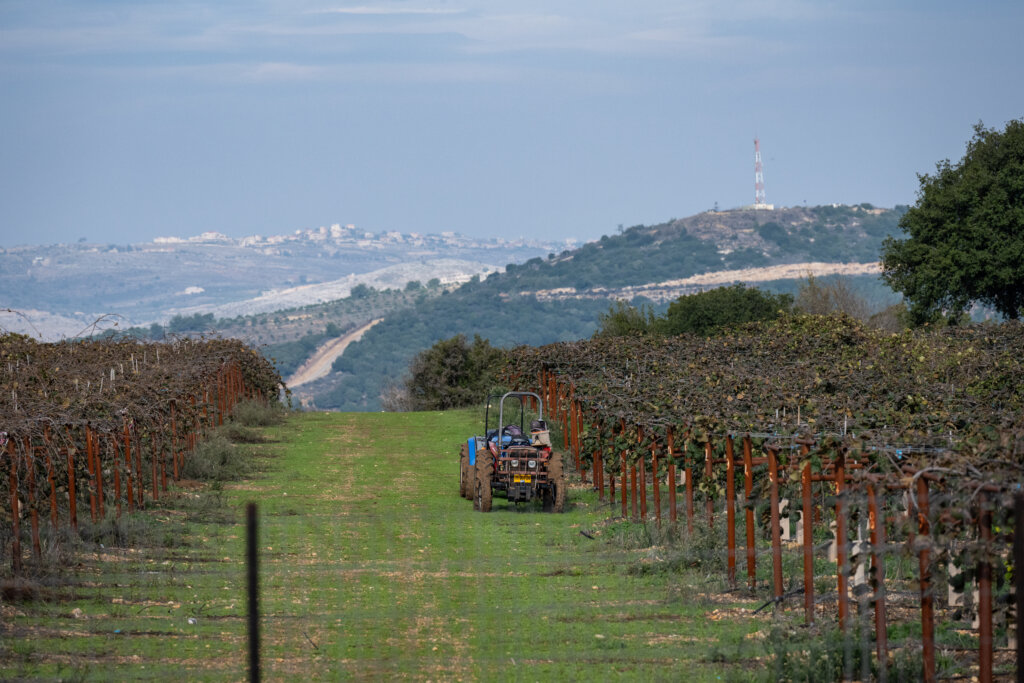
That all may be an inkling of the devastation that could rain down on the Galilee and Golan Heights if Iran or its proxies makes good on threats to avenge the assassination of Haniyeh.
If the situation was unbearable when I met Komarovsky earlier this month, it may soon be unimaginable.
So far, Mattat has been spared destruction, Komarovsky said, because it’s situated on a mountain above Lebanese territory, and the rockets target more low-lying areas. One farmer was killed in his fields this past December by a Hezbollah anti-tank missile.
“I keep going back,” Komaovsky said. “To my beautiful, beautiful garden. I need it. It keeps me sane.”
Food as resistance
In the immediate aftermath of Oct. 7, Komarovsky joined with other chefs to cook thousands of meals for displaced Israelis and soldiers. That sense of the country pulling together for support through suffering has faded as the war has dragged on, he said, and political divisions have re-hardened.
“We are considered enemies,” he said of anti-government protesters like himself.
His anger, if not disgust, with his government — for the evacuation, for its vilifying of protesters — doesn’t dampen his love of the land itself, to which, despite the imminent threat of attack, he keeps returning.
Meanwhile, Komarovsky has no idea when life will return to Mattat. If families can’t move back before September, they will likely remain away for the school year.
In the meantime, the village has been overtaken by a different kind of life. Wild animals from the surrounding forest have filled the void left by people. Wolves, coyotes, porcupines and badgers roam the once-lively streets and yards.
Komarovsky showed me a photo of the badgers that rampage through his pumpkins and tomatoes, stripping the vines clean. He’s tried to scare them off, to no avail.
“They’re smart,” he said. “And they couldn’t care less.”
Defiantly ‘local’
I met Komarovsky one hot, muggy Tel Aviv day at his newest ventures, Baladi Chic and Shawarma Weisberg, two fast-casual restaurants that share the ground floor space of a new office high rise.
“Come hungry,” he had messaged me the night before.
Baladi Chic — baladi is Arabic for “of the land” — features its name in Arabic on a chalkboard sign.
“Someone told me I shouldn’t display Arabic writing,” said Komarovsky. “I told them to forget it.”
The Israeli-born chef has a history of left-wing activism. During the Second Intifada, when many Israelis were staying away from Arab restaurants, Komarovsky initiated a collaboration with one of Nazareth’s oldest Arab restaurants, to, he said, “restore trust.”
He has no patience for anti-Arab bigots, or for those who think an Israeli Jew has no right to cook baladi food.
Baladi can also be translated as “local,” which is a key to understanding Komarovsky’s approach to food, and his resistance to giving up on his northern home.
In a 2017 profile of Komarovsky by Joan Nathan in The New York Times, Komarovsky said he initially set out in his career to cook local food. In so doing, he helped define Israeli cuisine.
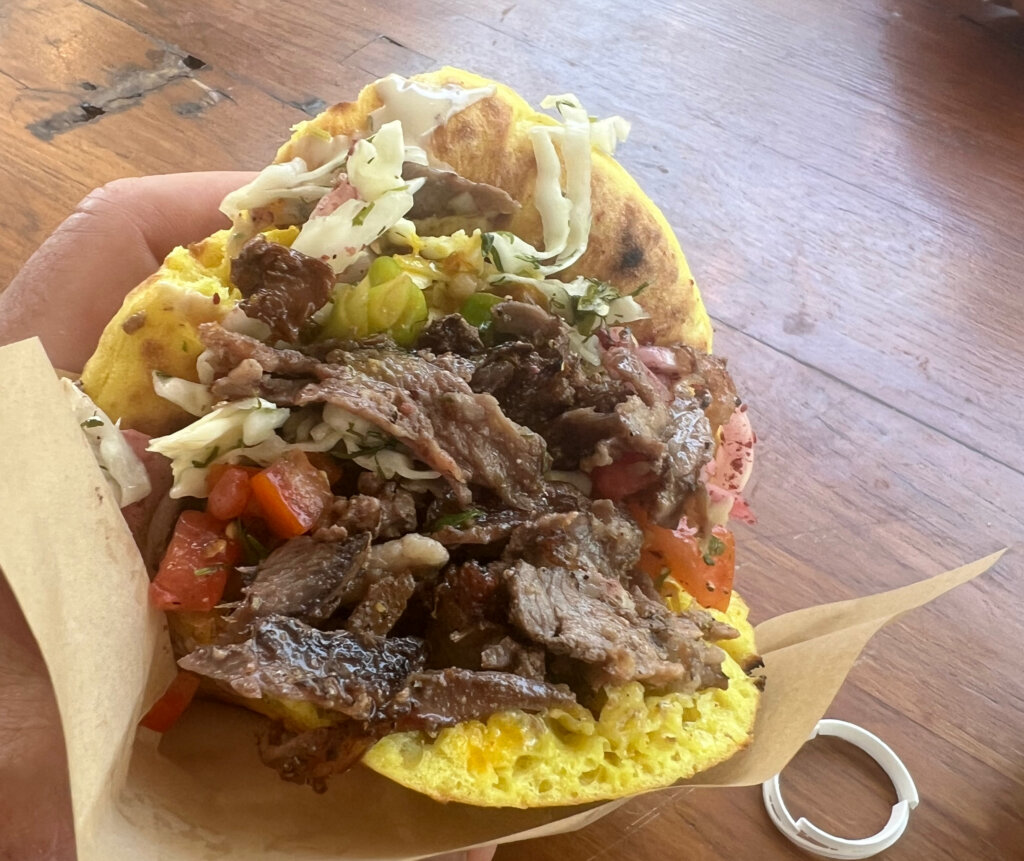
At a time when self-appointed referees of authenticity criticize, or even protest, Israeli chefs drawing on foods of the region as “cultural appropriation,” Komarovsky is unfazed.
“P.C. fashions are like a double-edged sword,” he said. “Sometimes you’re up, and sometimes you’re down.”
The Israeli right may attack him for his left-wing views, the global left for his drawing on Arab cuisine and ingredients, and the government may demand he evacuate, but Komarovsky, with a stubborn connection to his home, keeps cooking.
Maybe his stubbornness is emblematic of the attachment the vast majority of Israelis, Arabs and Jews, feel to their homeland, something their enemies, at home and abroad, are unable to grasp. But Komarovsky lives that attachment each week. He cooks it right into his food.
At lunch, Komarovsky presented me with a shawarma from the sandwich shop, which is named after his grandfather. The soft, freshly-made pita was tinted yellow, infused with turmeric, and the tender meat and creamy tahini stuffed inside was fragrant with freshly roasted and ground spice — a Komarovsky passion. The jars of coriander, cumin, fenugreek and other spices that line the restaurant walls were clearly not just for decoration.
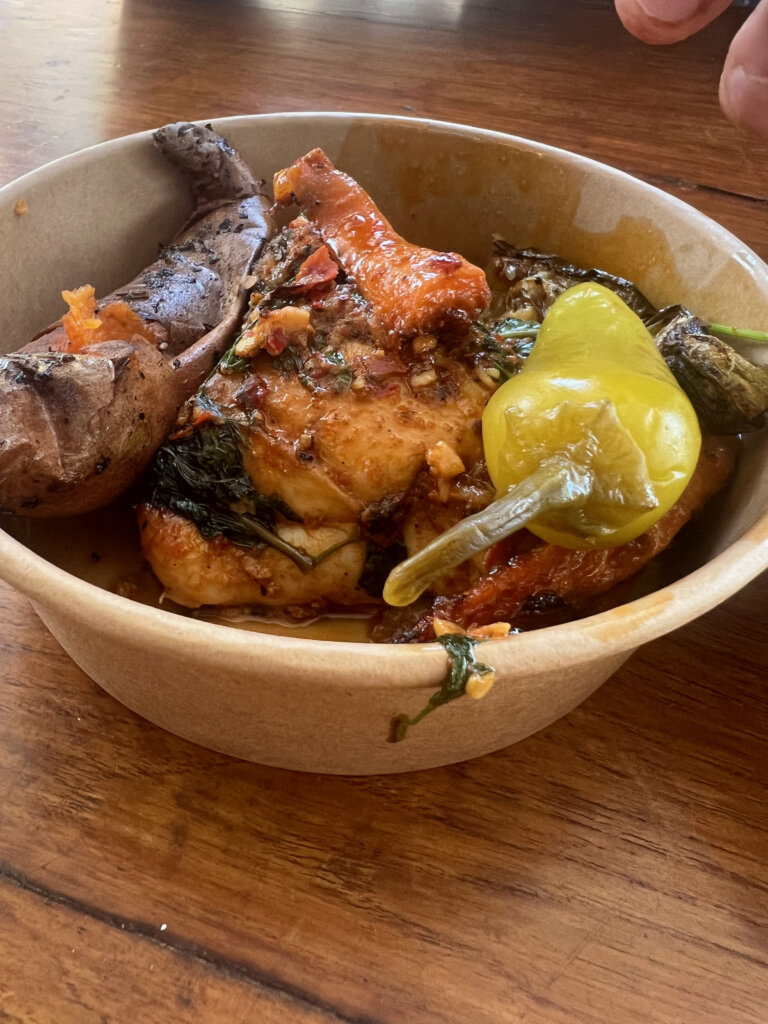
A server brought out two dishes from Baladi Chic, whose counter is lined with platters and pots filled with salads, stews and roasts.
There was chicken braised with sweet potato and green chile, bathed in a lemony herb sauce, and meatballs in a roasted tomato sauce with eggplant and onions. It was Mattat in Tel Aviv.
At lunch, he told me a full scale war between Hezbollah and Israel was unlikely, because there is a “balance of fear” between Israel and the terror group’s backer, Iran. So the stalemate, and intermittent exile, would drag on.
But after the cataclysms of the past week, I checked in with Komarovsky via email to see if he was finally planning to leave his home, and land.
“On the contrary,” he wrote: After the Beirut strike, he returned as usual to Mattat, where he built a wood shed for his outdoor oven, planted fig trees, and “harvested as many tomatoes as possible.”
I asked he still believes the “balance of fear” would hold.
“Still hoping there won’t be an all-out war,” he wrote from his home in Mattat. “Not sure of anything.”










